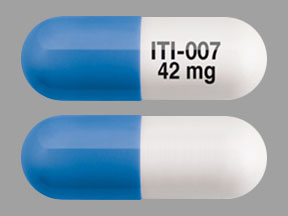Lumateperone and Alcohol/Food Interactions
There are 4 alcohol/food/lifestyle interactions with lumateperone.
Alcohol (Ethanol) Lumateperone
Moderate Drug Interaction
Using lumateperone together with ethanol may increase side effects such as dizziness, drowsiness, confusion, and difficulty concentrating. Some people may also experience impairment in thinking, judgment, and motor coordination. You should avoid or limit the use of alcohol while being treated with lumateperone. Do not use more than the recommended dose of lumateperone, and avoid driving, operating machinery, or engaging in potentially hazardous activities requiring mental alertness and motor coordination until you know how the medication affects you. Talk to your doctor if you have any questions or concerns. It is important to tell your doctor about all other medications you use, including vitamins and herbs. Do not stop using any medications without first talking to your doctor.
Lumateperone Food
Moderate Food Interaction
Grapefruit and grapefruit juice may increase the blood levels of lumateperone. In some cases, this may increase the risk of side effects such as drowsiness, abnormal muscle movements, seizures, high blood sugar, diabetes, high cholesterol, weight gain, low white blood cell count, difficulty swallowing, and heat-related disorders such as heat intolerance or heat stroke. You may also be more likely to experience side effects associated with low blood pressure such as dizziness. You should avoid the consumption of grapefruit and grapefruit juice during treatment with lumateperone. Be sure to take the medication with food. Talk to your doctor if you have any questions or concerns. It is important to tell your doctor about all other medications you use, including vitamins and herbs. Do not stop using any medications without first talking to your doctor.
Lumateperone Obesity
Moderate Potential Hazard, Moderate plausibility
atypical antipsychotic agents - hyperglycemia/diabetes
Hyperglycemia, in some cases extreme and associated with ketoacidosis or hyperosmolar coma or death, has been reported with the use of atypical antipsychotic agents. Patients with diabetes should be monitored for worsening control of blood glucose when treated with these agents. It is recommended that patients with risk factors for diabetes mellitus starting treatment with atypical antipsychotics should undergo fasting blood glucose testing at the beginning of treatment, and periodically thereafter. Any patient treated with atypical antipsychotics should be monitored for symptoms of hyperglycemia including polydipsia, polyuria, polyphagia, and weakness. Patients who develop symptoms of hyperglycemia during treatment with atypical antipsychotics should undergo fasting blood glucose testing. In some cases, hyperglycemia has resolved when treatment with these agents was discontinued; however, some patients required continuation of anti-diabetic treatment despite discontinuation of the atypical antipsychotic drug.
References
- (2001) "Product Information. Clozaril (clozapine)." Novartis Pharmaceuticals
- (2001) "Product Information. Risperdal (risperidone)." Janssen Pharmaceuticals
- (2001) "Product Information. Zyprexa (olanzapine)." Lilly, Eli and Company
- (2001) "Product Information. Seroquel (quetiapine)." Astra-Zeneca Pharmaceuticals
- (2001) "Product Information. Geodon (ziprasidone)." Pfizer U.S. Pharmaceuticals
- (2002) "Product Information. Abilify (aripiprazole)." Bristol-Myers Squibb
- (2007) "Product Information. Invega (paliperidone)." Janssen Pharmaceuticals
- (2009) "Product Information. Fanapt (iloperidone)." Vanda Pharmaceuticals Inc
- (2009) "Product Information. Saphris (asenapine)." Schering-Plough Corporation
- (2010) "Product Information. Latuda (lurasidone)." Sunovion Pharmaceuticals Inc
- (2015) "Product Information. Rexulti (brexpiprazole)." Otsuka American Pharmaceuticals Inc
- (2015) "Product Information. Vraylar (cariprazine)." Actavis Pharma, Inc.
- (2022) "Product Information. Caplyta (lumateperone)." Intra-Cellular Therapies, Inc., SUPPL-9
Lumateperone High Cholesterol (Hyperlipoproteinemia, Hypertriglyceridemia, Sitosterolemia)
Moderate Potential Hazard, Moderate plausibility
atypical antipsychotic agents - lipid alterations
Atypical antipsychotic drugs have been associated with undesirable alterations in lipid levels. While all agents in the class have been shown to produce some changes, each drug has its own specific risk profile. Before or soon after initiation of antipsychotic medications, a fasting lipid profile should be obtained at baseline and monitored periodically during treatment.
References
- (2001) "Product Information. Clozaril (clozapine)." Novartis Pharmaceuticals
- (2001) "Product Information. Risperdal (risperidone)." Janssen Pharmaceuticals
- (2001) "Product Information. Zyprexa (olanzapine)." Lilly, Eli and Company
- (2001) "Product Information. Seroquel (quetiapine)." Astra-Zeneca Pharmaceuticals
- (2001) "Product Information. Geodon (ziprasidone)." Pfizer U.S. Pharmaceuticals
- (2002) "Product Information. Abilify (aripiprazole)." Bristol-Myers Squibb
- (2007) "Product Information. Invega (paliperidone)." Janssen Pharmaceuticals
- (2009) "Product Information. Fanapt (iloperidone)." Vanda Pharmaceuticals Inc
- (2009) "Product Information. Saphris (asenapine)." Schering-Plough Corporation
- (2010) "Product Information. Latuda (lurasidone)." Sunovion Pharmaceuticals Inc
- (2015) "Product Information. Rexulti (brexpiprazole)." Otsuka American Pharmaceuticals Inc
- (2015) "Product Information. Vraylar (cariprazine)." Actavis Pharma, Inc.
- (2022) "Product Information. Caplyta (lumateperone)." Intra-Cellular Therapies, Inc., SUPPL-9
Lumateperone drug interactions
There are 588 drug interactions with lumateperone.
Lumateperone disease interactions
There are 10 disease interactions with lumateperone which include:
- suicidality
- dementia
- aspiration
- seizure
- hematologic abnormalities
- hyperglycemia/diabetes
- hypotension
- lipid alterations
- hepatic impairment
- tardive dyskinesia
More about lumateperone
- lumateperone consumer information
- Check interactions
- Compare alternatives
- Reviews (162)
- Side effects
- Dosage information
- During pregnancy
- Drug class: atypical antipsychotics
- Breastfeeding
- En español
Related treatment guides
Drug Interaction Classification
| Highly clinically significant. Avoid combinations; the risk of the interaction outweighs the benefit. | |
| Moderately clinically significant. Usually avoid combinations; use it only under special circumstances. | |
| Minimally clinically significant. Minimize risk; assess risk and consider an alternative drug, take steps to circumvent the interaction risk and/or institute a monitoring plan. | |
| No interaction information available. |
Further information
Always consult your healthcare provider to ensure the information displayed on this page applies to your personal circumstances.


